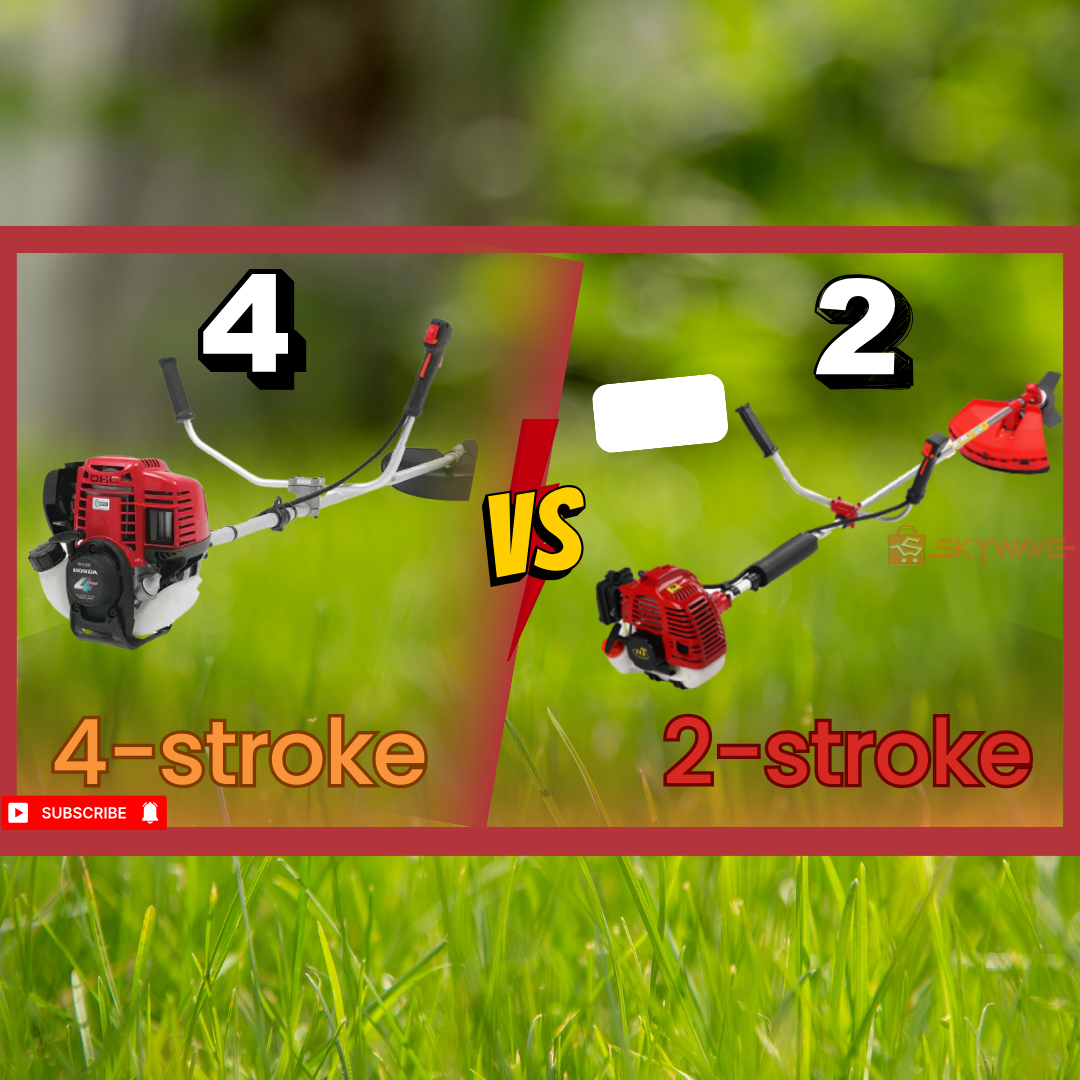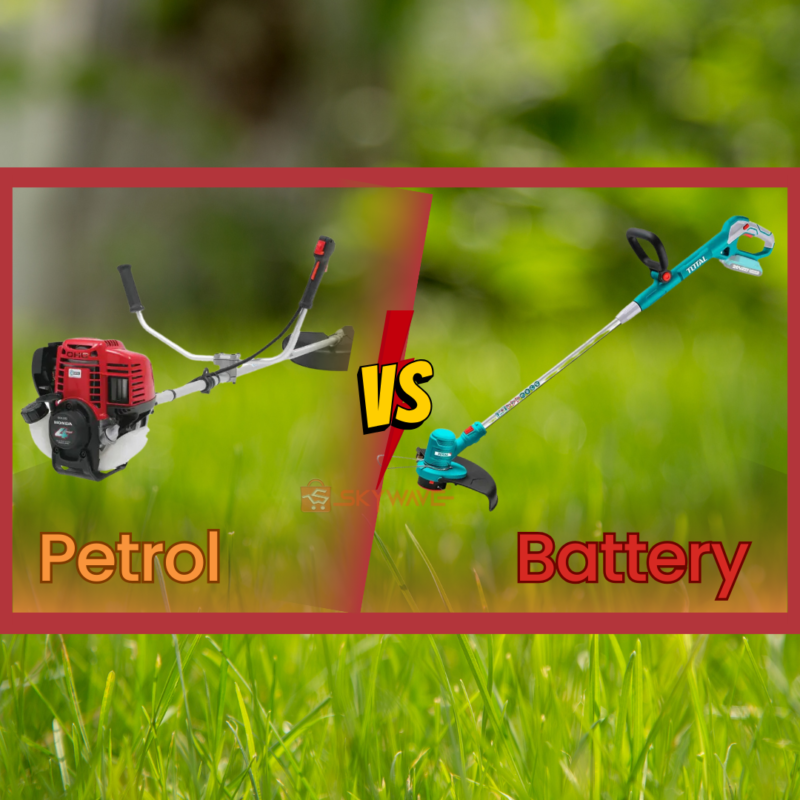Blog Posts
4-Stroke and 2-Stroke Brush Cutters: Understanding Their Differences

Introduction
Brush cutters are powerful gardening tools designed to tackle thick weeds, overgrown grass, and small bushes, making them essential for maintaining large outdoor spaces. These versatile machines come in various forms, with the most common types being 4-stroke and 2-stroke brush cutters. Understanding the differences between the 4-stroke and 2-stroke Brush Cutters is crucial for selecting the right equipment for your specific needs and ensuring optimal performance.
As we delve deeper into the topic, we’ll explore the specific pros and cons of 4-Stroke and 2-Stroke Brush Cutters, their similarities, and why one might be more suitable than the other depending on your gardening needs. By the end of this discussion, you will have a comprehensive understanding of 4-stroke and 2-stroke brush cutters, empowering you to make an informed decision for your landscaping tasks. Let’s get started !!!!
4-stroke and 2-stroke brush cutters
The primary distinction between 4-stroke and 2-stroke Brush Cutters lies in their engine mechanics. A 4-stroke engine completes a power cycle in four steps: intake, compression, power, and exhaust. This type of engine is known for its efficiency and lower emissions. On the other hand, a 2-stroke engine completes the same power cycle in just two steps: compression and power, making it more powerful but also louder and less fuel-efficient.
Advantages of 4-Stroke Brush Cutters
When considering the type of brush cutter to invest in, the 4-stroke brush cutter offers numerous advantages that make it a preferred choice for many users. These advantages include:
- Superior fuel efficiency – Unlike 2-stroke engines that mix oil and fuel, a 4-stroke engine operates on pure gasoline, leading to more efficient combustion and less frequent refueling. This efficiency not only saves money in the long run but also reduces the overall environmental impact.
- Lower emissions – The cleaner combustion process releases fewer pollutants into the atmosphere, making these machines more eco-friendly. This is particularly beneficial for users who are conscious of their environmental footprint or are required to adhere to strict emission regulations in their area.
- Noise pollution – Their design allows for quieter operation compared to 2-stroke models, which can be a significant advantage in residential areas or for prolonged use. This quieter operation is often cited in user testimonials as a major benefit, contributing to a more pleasant working environment.
- Durability and longevity – The complex engine design, while initially more expensive, translates to a longer lifespan. These machines are built to withstand extensive use, making them ideal for larger and more sustained tasks. Furthermore, the smoother power delivery of 4-stroke engines ensures consistent performance, which is crucial for demanding applications.
- Maintenance – They typically require less frequent servicing compared to their 2-stroke counterparts. The absence of the oil-fuel mixture reduces the risk of engine clogging and other related issues. This ease of maintenance is a significant advantage for both casual users and professionals who need reliable equipment that doesn’t demand constant attention.
Real-world examples underscore these advantages. For instance, landscape professionals often prefer 4-stroke brush cutters for their fuel efficiency and durability, which translate to cost savings and reliable performance over time. User testimonials frequently highlight the quieter operation and lower maintenance requirements, reinforcing the practical benefits of choosing a 4-stroke model.
Advantages of 2-Stroke Brush Cutters
2-stroke brush cutters offer several notable advantages that make them a popular choice for various cutting tasks.
- Simplicity. Unlike their 4-stroke counterparts, 2-stroke engines have fewer moving parts, which translates to less maintenance and fewer repairs. This simplicity also makes these brush cutters more cost-effective to maintain over time.
- Lighter weight – The reduced weight allows for greater maneuverability and ease of use, particularly in challenging terrains or during prolonged periods of operation. This attribute is especially beneficial for users who need to cover large areas or work in dense vegetation, as it reduces operator fatigue and enhances overall efficiency.
- Higher power – The higher power-to-weight ratio of 2-stroke brush cutters is a critical factor in their performance. These engines deliver more power relative to their weight, enabling quick and powerful bursts of cutting. This makes them ideal for tackling tough undergrowth, thick brush, and other demanding cutting scenarios where immediate and intense power is required. The ability to generate high RPMs quickly ensures that 2-stroke brush cutters can handle even the most stubborn vegetation with ease.
Practical scenarios where 2-stroke brush cutters excel include clearing overgrown gardens, managing underbrush in forests, and maintaining roadside vegetation. Their robust performance in dense and challenging environments makes them a reliable tool for both professional landscapers and DIY enthusiasts.
In summary, the advantages of 2-stroke brush cutters lie in their simplicity, lighter weight, and superior power-to-weight ratio. These attributes make them an excellent choice for users seeking a powerful, easy-to-handle tool for a variety of cutting tasks. Whether dealing with dense vegetation or requiring quick bursts of power, a 2-stroke brush cutter is a dependable option that delivers consistent performance.
Key Differences between a 4-stroke or a 2-stroke Brush Cutter
To make an informed decision, you need to understand the core differences between 4-stroke and 2-stroke brush cutters. Here’s a detailed comparison:
| Aspect | 4 Stroke Brush Cutter | 2 Stroke Brush Cutter |
|---|---|---|
| Engine Type | Runs on four cycles: intake, compression, power, and exhaust. | Runs on two cycles: compression and power. |
| Fuel Efficiency | More fuel-efficient as it uses less fuel over time. | Less fuel-efficient due to higher fuel consumption. |
| Maintenance | Requires regular oil changes but generally low maintenance. | Less complex but requires mixing oil with fuel. |
| Performance | Provides consistent power and is quieter. | Generally more powerful but noisier. |
| Weight | Heavier due to more components. | Lighter and easier to handle. |
Factors to Consider When Choosing a 4-stroke or a 2-stroke Brush Cutter
When deciding between 4-stroke and 2-stroke Brush Cutters, various factors must be considered to ensure you select the right tool for your needs. The 4-stroke and 2-stroke Brush Cutters serve the same fundamental purpose to clear thick vegetation and manage overgrown areas. However, their differences can significantly impact their performance and suitability for specific tasks.
1. Type of Work
The nature of the work you intend to perform is a critical factor. A 4-stroke brush cutter is typically more powerful and better suited for heavy-duty tasks, such as clearing dense brush or thick grass. On the other hand, a 2-stroke brush cutter is lighter and more maneuverable, making it ideal for lighter, more frequent trimming jobs.
2. Frequency of Use
The frequency with which you plan to use the brush cutter also plays a role. For regular, extensive use, a 4-stroke brush cutter might be more appropriate due to its durability and efficiency. Conversely, for occasional use, a 2-stroke brush cutter, with its simpler design and ease of maintenance, may be more suitable.
3. Environmental Considerations
Environmental impact is another important aspect. 4-stroke engines are generally more fuel-efficient and produce fewer emissions compared to 2-stroke engines, making them a more environmentally friendly option. This might be a deciding factor for those looking to minimize their carbon footprint.
4. Budget
Budget constraints cannot be ignored. 2-stroke brush cutters are usually less expensive upfront and cheaper to repair, making them a more attractive option for budget-conscious users. However, 4-stroke brush cutters, while more costly initially, can offer savings in the long run through better fuel efficiency and lower emissions.
5. Personal Comfort
Personal comfort and ease of use are also vital factors. 4-stroke brush cutters tend to be heavier, which might be a drawback for prolonged use. In contrast, 2-stroke models are lighter and easier to handle, reducing operator fatigue.
Conclusion
Understanding the differences between 4-stroke and 2-stroke brush cutters can help you make an informed choice that best suits your gardening or landscaping needs. Despite these differences, both 4-stroke and 2-stroke brush cutters share similarities in their intended purpose and basic operational principles. They both require regular maintenance. By weighing these factors, users can make an informed decision when choosing between 4-stroke and 2-stroke Brush Cutters that best suit their specific needs and preferences.

